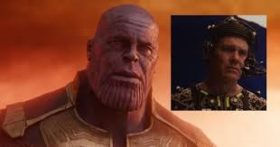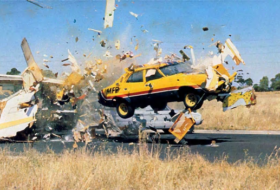
Every day until the Oscars ceremony we’ll be highlighting a different category or movie here on the LAMB! Here’s a link to all the posts written so far:
Today, Jeanette Ward from The Mundane Adventures of a Fangirl is here to look at the nominees for Best Visual Effects.
Tnx Jeanette!
BEST VISUAL EFFECTS
Visual Effects (VFX) is imagery created or manipulated outside the context of a live action shot in filmmaking. The Academy Award for Best Visual Effect was first awarded in 1929, when it was called Best Engineering Effects and went to the best picture winner – Wings. It officially became a regularly awarded category in 1938, but it was still sporadically given. From 1939 to 1963 the “Best Special Effects” Oscar was for visual and audio effects combined. In 1964 they separated, and this was changed to Best Special Visual Effects.
In case you are curious, past winners include Mighty Joe Young in 1949, 20,000 Leagues Under the Sea in 1954, The Ten Commandments beating Forbidden Planet in 1956, Cleopatra in 1963, 2001: A Space Odyssey in 1968, Bedknobs and Broomsticks in 1971, Star Wars in 1977 (Empire and Jedi also won their years), Superman in 1978, Alien in 1979, and Innerspace beat Predator in 1987. I love Innerspace, but there’s no way tiny Dennis Quaid inside Martin Short is better than the Predator. Industrial Light & Magic (ILM) superstar Dennis Muren holds the record for most wins, 8.
This year, there are five nominees for the award:
Avengers: Infinity War – Dan DeLeeuw, Kelly Port, Russell Earl, and Dan Sudick
Infinity War starts in space in the ruins of the Asgardian ship. Thanos, the mad Titan, uses the one infinity stone he already has (the power stone) to eliminate half of the Asgardians, pummel Thor and Loki, demand the space stone, and then just has a straight up fist fight with the Hulk. This is the first 15 minutes of the movie and the effects are already incredible. The center to this entire movie is the performance-capture depiction of Thanos by Josh Brolin as he goes from place to place, collecting the six stones which he needs to establish balance in the universe.

The result allows Thanos to be the center of the film, and the exquisite performance by Brolin is almost enough to make you see Thanos’s point….almost. The movie also includes a battle with aliens in New York during which two wizards with digital powers, one digital Iron Man, and one digital Spider-Man pretty much lose to two completely digital aliens. There’s also a visit to Titan, Thanos’s home world, which is now in ruins – but then Thanos uses the reality stone to give everyone a peek at what it used to look like. ILM created an incredible battle sequence in Wakanda that just about uses every digital trick in the book.

And not to mention, Rocket and Groot are featured in this. A foul-mouthed space raccoon and a teenage tree with a bad attitude should be the win-with-no-contest point for any visual effects Oscar.
Christopher Robin – Christopher Lawrence, Michael Eames, Theo Jones, and Chris Corbould
In Christopher Robin, the adult Christopher played by Ewan McGregor has become swamped by his work life and has been neglecting his personal life, planning to send his daughter to boarding school. His childhood friends, Pooh, Tigger, Piglet, Eeyore and the rest show up to remind him who he is, and where he came from (it’s basically the same story as Hook).

The visual effects are used to bring to life the plush friends from the Hundred Acre Woods in a live-action sort of way. They look a little too real, and in my opinion come off more terrifying than cuddly, but still – an impressive feat. McGregor was grateful to shoot with the plush versions of the characters while having the voice actors on hand to give him something to react to.
First Man – Paul Lambert, Ian Hunter, Tristan Myles, and J.D. Schwalm
First Man is the based-on-a-true-story of test pilot Neil Armstrong as he prepares to be the first man on the moon. The effects in this are largely used to recreate the details of the late 60s space race, and the missions leading up to Armstrong’s step on the moon.

Instead of using green screens, they created LED displays of projected images to simulate the exterior views from the spacecraft, both of earth and space. Director Damian Chazelle believed this would help the performances of the actors because they could stay in the moment, and not be distracted by a large sheet of green.
Ready Player One – Roger Guyett, Grady Cofer, Matthew E. Butler, and David Shirk
Ready Player One is directed by Steven Spielberg and based on the book of the same name from 2011, in which Spielberg is name-checked a whole bunch of times. The movie follows the story of Wade Watts, a kid living in 2045 who spends most of his life in the OASIS, a virtual world where you can be and do pretty much anything you want. One of the co-creators of the OASIS, James Halliday, has passed away, and left an ‘easter egg’ somewhere in the OASIS that will allow the holder to own the system. Wade and his friends, Aech, Art3mis, Daito, and Sho are racing to find the egg before Sorrento and the IOI, a company that wants to start charging everyone for using the OASIS. Almost the entire movie is visual effects because it all takes place inside the virtual world of the OASIS. Part of the fun of this is recreating famous pop culture references from other movies and TV shows.

While it all looks amazing, it often is a bit overwhelming, and doesn’t really allow you to focus on any one piece. The stand-out sequence is not from the book, but a unique sequence for the movie that recreates the hotel from The Shining.

ILM used a combination of the original footage and digital add-ons, along with post-processing aging to make the new footage indistinguishable from the original.
Solo: A Star Wars Story – Rob Bredown, Patrick Tubach, Neal Scanlan, and Dominic Tuohy
Solo feels like a space western, and follows the story of a young Han Solo, escaping from indentured servitude on Corellia by joining the Imperial Navy in the hopes of returning to Corellia someday to rescue his love, Qi’ra. Along the way, he meets the Wookie warrior Chewbacca, the gambler Lando Calrissian, and other characters we meet for the first time.

Solo partners up with Tobias Beckett to run a scam for the crime boss Dryden Vos all while trying to evade the Cloud Riders, led by Enfys Nest. The effects are once again by ILM, and include incredible shots of a train heist through snowy mountains, a gambling hall with incredible alien patrons, Lando’s cape collection, and of course, we finally get to see the beloved Millennium Falcon make the Kessel Run in less than twelve parsecs.

The look is lovely, and the action is spectacular – even if pieces of the story were a little weak.
Who Should Win:
Without a doubt in my mind, Infinity War should win. The sheer amount of world-building done was mind-blowing, not to mention the exceptional performance capture technology with multiple characters. The final Wakandan battle sequence and the devastating after-effects of THE SNAP all speak to visual effects used at the very highest level to enhance the storytelling of a masterpiece.

Who Will Win:
Infinity War. But, the Academy has a habit of preferring a ‘film’ over a ‘movie’ which is frustrating because this is one of the few categories where ‘movies’ get nominated and recognized. In addition to that, they love when effects are used to tell a true story. It would make me angrily yell at the TV, but I could see First Man getting the trophy.

Who do you think deserves the prize this year?






Great piece Jeanette, thanks. Glad you agree that Pooh and friends have sprung from our nightmares. I agree that Infinity War should take this as the sheer volume and variety of effects required is phenomenal, yet they all flow so seamlessly, whereas Ready Player One, which is like 70% effects shots, doesn’t always get it right.
Im picking Ready Player One but could easily see The voters picking First Man. If Black Panther was nominated it would be a for sure win. I guess we will wait and see